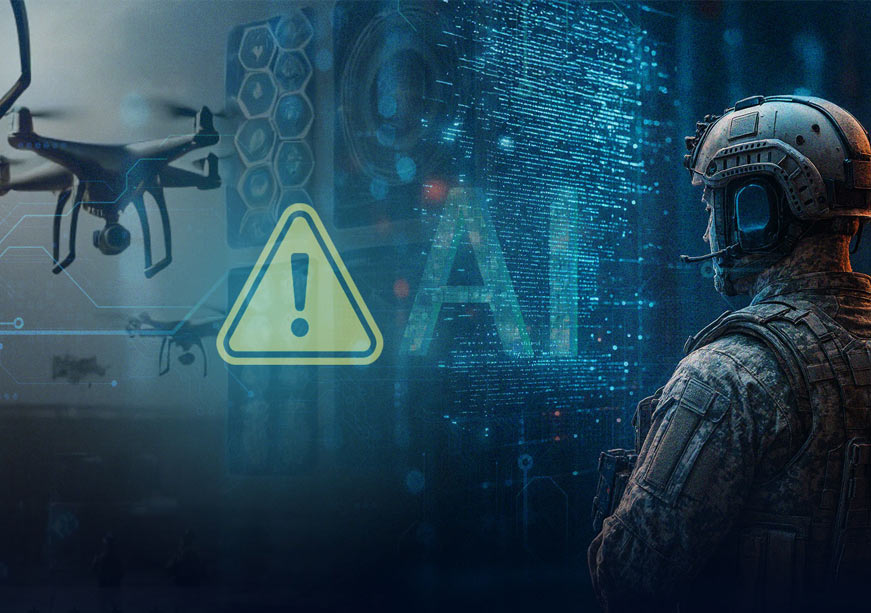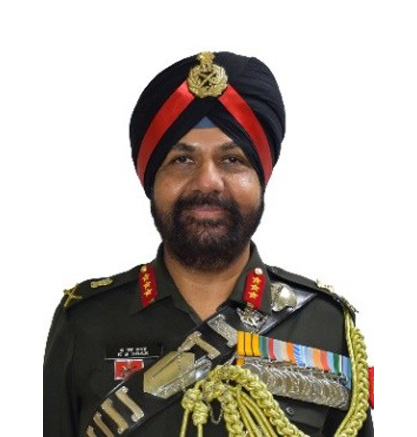-
CENTRES
Progammes & Centres
Location
Winning in an AI world requires mastering both fronts—developing AI for warfare and defending against warfare in a world run by AI

Artificial Intelligence (AI) has become a domain-defining force in warfare by fundamentally altering how militaries gather information, make decisions, and execute combat. Instead of replacing human soldiers, it acts as a “force multiplier,” enhancing speed, precision, and strategic foresight while introducing new ethical and geopolitical challenges. There are many reports of AI usages in conflicts in recent times—an AI-assisted targeting by Israel Defense Forces using an AI system called “Lavender” (and a complementary system “Gospel”) to process surveillance data and generate tens of thousands of potential human and structural targets in the Gaza conflict and in Russia-Ukraine conflict, of an AI-enabled drone/FPV swarm warfare in the Ukraine-Russia war.
The impact of AI on warfare unfolds on two interconnected but distinct fronts—“AI in warfare” and “warfare in an AI world”. Understanding this aspect and developing both simultaneously is going to be the cornerstone of future national security.
As AI penetrates every domain of human activity, the distinction between “AI in warfare” and “warfare in an AI world” becomes more than academic—it defines the future of power, deterrence, and survival.
As AI penetrates every domain of human activity, the distinction between “AI in warfare” and “warfare in an AI world” becomes more than academic—it defines the future of power, deterrence, and survival. The two may sound similar, but they shape military strategy, ethics, and policy in profoundly different ways. Understanding the difference is essential for any nation seeking to remain secure and sovereign in the algorithmic age.
Failing to distinguish the two can be perilous. If nations treat AI merely as another weapon, they will focus on building smarter arsenals. But the real challenge lies in adapting to an AI-shaped world—where information, perception, and control are the new high grounds. Recognising this distinction ensures balanced policy development: integrating AI into defence responsibly while also preparing society, governance, and diplomacy for the deeper transformation AI brings or will do so in future.
“AI in Warfare” is the tactical and operational use of AI by militaries within the traditional military framework. Here, AI acts as a force multiplier—enhancing human capability in surveillance, logistics, targeting, maintenance, and decision support. It makes every sensor smarter, every decision faster, and every system more adaptive. The OODA loop—Observe, Orient, Decide, Act—is compressed beyond human speed, for e.g. as seen in the US military strikes in Syria, Iraq, etc., shortened the OODA loop with the use of AI to strike targets in real time.
AI acts as a force multiplier—enhancing human capability in surveillance, logistics, targeting, maintenance, and decision support.
Autonomous drones, predictive maintenance for equipment, AI-assisted targeting, and decision-support systems are no longer concepts; they are becoming operational realities. ISR superiority is being achieved through machine learning analysis of multi-sensor data, decision acceleration through AI-assisted battle management (ie Indrajaal used in Operation Sindoor) and cyber defence through AI-based threat detection and anomaly response systems. In AI in Warfare approach, regulation focuses on ethics, accountability, and control—e.g., human-in-the-loop approaches, laws of armed conflict, and weapon autonomy.
Warfare in an AI World is not about using AI as a weapon—it’s about fighting in a world that runs on AI. It examines how the very nature of conflict is changing when societies, economies, and command systems all depend on algorithms. In this world, data becomes both terrain and target.
Tomorrow’s conflicts will be shaped by new kinds of battles in which it will be:
The centre of gravity will not only be the military capabilities of the Nation but will include the digital/technological, cognitive, economic and algorithmic domains, inter alia, the Nation itself.
This new kind of warfare blurs the lines between civilian and military, peace and conflict. Warfare now happens within the systems that sustain modern life — from financial algorithms and media platforms to logistics networks and decision-support systems. These changes demand new kinds of governance, not just military, but societal and international. Ultimately, “Warfare in an AI World” is about the transformation of the entire battlespace and society by AI. Power now lies not only in missiles and tanks, but in data sovereignty, compute control, and the ability to shape information itself. The centre of gravity will not only be the military capabilities of the Nation but will include the digital/technological, cognitive, economic and algorithmic domains, inter alia, the Nation itself.
Right now (at least), AI is a tool, but as it becomes integrated into infrastructure, economy, and cognition, it will evolve into a tissue—something that connects all systems, much like the nervous system connects organs. That’s when AI becomes functionally all-pervasive, even if not physically so.
These two fronts are not sequential; they are mutually reinforcing. AI in warfare delivers immediate advantage, but without preparing for warfare in an AI world, nations risk vulnerability in their infrastructure, data, and governance systems.
If only the first is pursued, technology outpaces ethics and strategy. If only the second, doctrine outpaces capability. The solution is to develop both together, with distinct institutions, but an integrated vision.
The rapid advancement of AI technologies is compelling policymakers and regulators worldwide to recognise the urgency of shared understandings, norms and regulations that transcend national borders and geopolitical competition.
To address this challenge, initiatives have been launched in recent times. UNIDIR, in partnership with Microsoft, launched RAISE (Roundtable for AI security and Ethics) in March 2024, to foster multistakeholder dialogue on AI and security and defence. The Summit on Responsible Artificial Intelligence in the Military Domain, also known as REAIM 2023, regarding military uses of AI was held in the World Forum in The Hague on 15–16 February 2023. The second summit on the Responsible Use of Artificial Intelligence in the Military Domain (REAIM) held in Seoul, South Korea, in September 2024, resulted in the "Blueprint for Action" to govern responsible use and maintain international stability. It brought together governments, international organisations, technology companies, and civil society to ensure AI's safe and ethical application in military settings. Sixty countries endorsed the ‘Blueprint’, including the United States, but both China and India did not endorse it, and Russia was excluded from the event.
UNIDIR, in partnership with Microsoft, launched RAISE (Roundtable for AI security and Ethics) in March 2024, to foster multistakeholder dialogue on AI and security and defence.
These initiatives are voluntary, thus there are external calls for starting negotiations on an internationally binding law or an enforcement-mechanisms-driven law.
Notwithstanding the above initiatives, in the emerging AI era, more needs to be done, and no nation can secure itself in isolation. The challenges posed by autonomous systems, data dependencies, and algorithmic decision-making transcend borders, demanding new forms of international cooperation. A priority is the establishment of clear global standards for autonomous weapons and accountability mechanisms. Without shared norms, the risk of unintended escalation or misuse of AI-driven systems could destabilise global security. Equally vital are confidence-building measures—such as algorithmic transparency, notification protocols, and shared testing frameworks—to reduce mistrust and prevent what might be called algorithmic escalation, where competing AI systems act faster than human diplomacy can respond.
Nations must also forge joint research and development initiatives and secure data partnerships with trusted allies. Such collaborations will ensure resilience, interoperability, and equitable access to critical AI capabilities across the alliance network. Ultimately, leadership in global AI governance will become a defining measure of strategic power, implying India needs to take a more active role. States that shape the rules, norms, and ethical foundations of AI use in defence and security will command not only technological superiority but also moral and diplomatic legitimacy in the new era of warfare and peacekeeping.
The creation of the Defence AI Council (DAIC) and the Defence AI Project Agency (DAIPA) signals India’s serious commitment to AI integration. However, India needs to be more actively engaged in international forums.
For ‘AI in Warfare’, there is a requirement for an AI Operations Cell within the armed forces for rapid prototyping and field experimentation, pilot high-impact prototypes in ISR analytics, predictive maintenance, and AI-enabled logistics.
In our context, we need to establish institutional mechanisms for both types of warfare–‘AI in Warfare’ and ‘Warfare in AI World’. There is a requirement to build early capability to secure national interests, including establishing a National AI Defence Council (NAIDC) for inter-ministerial coordination and policy coherence. There is a need to conduct a National AI Dependency Audit that covers data access, compute capacity, and supplier ecosystems. There is also a need to issue preliminary AI ethics, human-in-loop, and safety guidelines on defence AI use. For ‘AI in Warfare’, there is a requirement for an AI Operations Cell within the armed forces for rapid prototyping and field experimentation, pilot high-impact prototypes in ISR analytics, predictive maintenance, and AI-enabled logistics.
The future of conflict will not be decided only by who builds the best AI weapons, but by who best understands how AI transforms the nature of war itself. Winning in an AI world requires mastering both fronts—developing AI for warfare and defending against warfare in a world run by AI. Only nations that grasp this duality will be able to ensure peace, deterrence, and control in the age where algorithms are as consequential as armies.
Lt Gen Karanbir Singh Brar, PVSM, AVSM (Retd). He currently is a Distinguished Strategic Advisor to IITM PRAVARTAK.
The views expressed above belong to the author(s). ORF research and analyses now available on Telegram! Click here to access our curated content — blogs, longforms and interviews.

The General Officer with a career spanning almost four decades has rich experience of serving in all terrain and operational areas with tenures in J&K, ...
Read More +